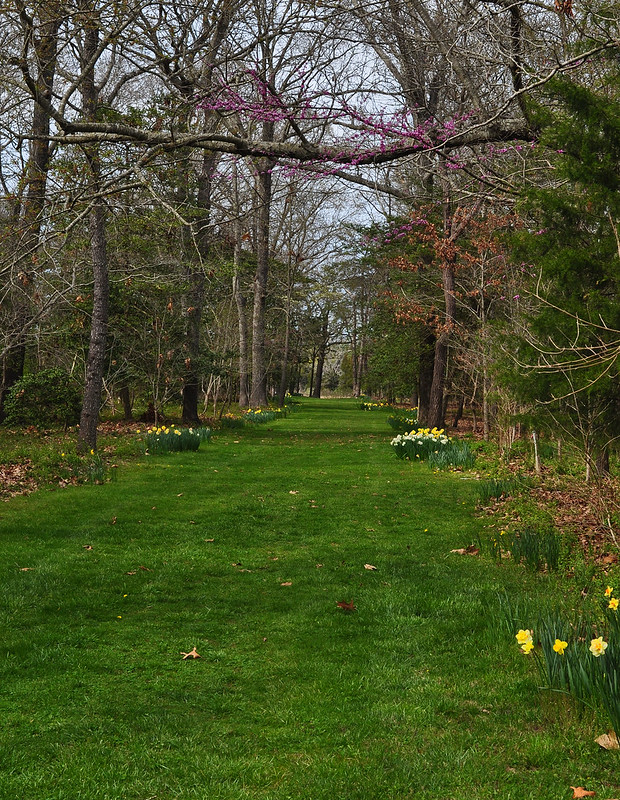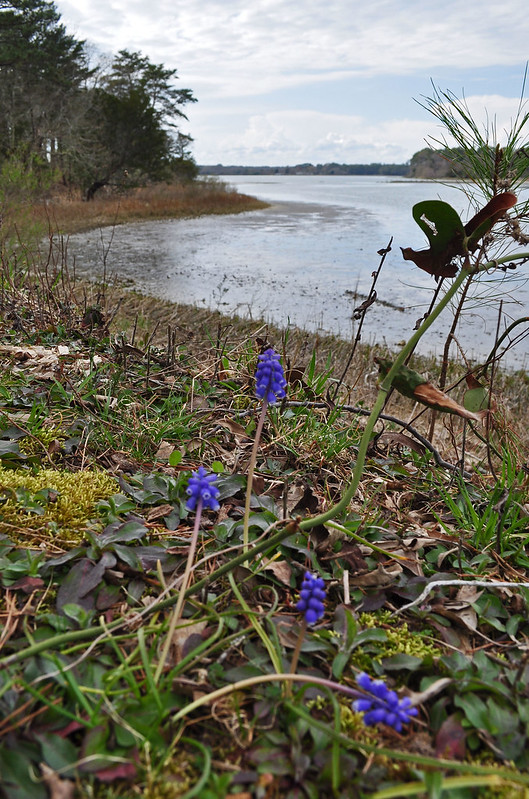Further south, the roads to old plantations were traditionally lined with live oaks, but in Tidewater it is done with eastern red cedar, and there is a about a mile of the trees lining the road to Eyre Hall.
April 4, 2017
Early Spring at Eyre Hall
This past week I crossed the bay to speak to a group of garden club ladies on the Eastern Shore. On the way back to Norfolk I decided to visit the gardens at Eyre Hall, especially since this was one of those rare trips to the Shore when I was unencumbered by either disinterested, impatient family members, or dogs suffering from a loud case of separation anxiety. I have been to the gardens about 4 times now, but never at this time of year. As I mentioned in my first post about Eyre Hall "The first members of the Eyre family settled here beside Cherrystone Creek in the 1660's, and about 100 years later, construction began on what was to become the family seat. Around 1800 a parterre garden was planted behind the house, and it is considered the oldest continually maintained ornamental garden in the state, and one of the oldest in the country. Today Eyre Hall is still occupied by descendants of the same family, and they graciously open the garden to the public without charge, and without appointment."
Further south, the roads to old plantations were traditionally lined with live oaks, but in Tidewater it is done with eastern red cedar, and there is a about a mile of the trees lining the road to Eyre Hall.
By an outbuilding, a large camellia was still in bloom. Overhead in an ancient Magnolia grandiflora a noisy flock of grackles seemed untroubled by my presence.
The garden is a series of large boxwood parterres separated from the surrounding fields by a fence of brick and wood. Inside the parterres, each is planted somewhat differently, but they all smell overwhelming of box. Overhead are more magnolias, and old crapemyrtles. Along one edge of the garden are the ruins of an orangery, and next to it the family cemetery.
The fence pictured in the previous photo and in the following is in the front of the house. Underneath the crapemyrtles are planted nothing but peonies, and the bed is full. I should come back later when they are blooming. Forsythia was finishing up beyond.
The axes (plural of axis - I had to google it) of the parterre garden line up with various windows and doors from the house. One axis goes all the way through the garden, uninterrupted, out the back gate, through a wide daffodil-lined woodland walk, and ends at Eyreville Creek. The woods on either side of the walk start off semi-cultivated and quickly go wild. One area under numerous hackberry trees had been completely overrun with Vinca major. At the waters edge escaped, but well behaved Muscari were blooming near a carpet of moss. Gulls, herons, and egrets created the soundtrack.
Eyre Hall is just off of busy Route 13, but far enough from the main road that you may lose track of time or even what year it is.
Further south, the roads to old plantations were traditionally lined with live oaks, but in Tidewater it is done with eastern red cedar, and there is a about a mile of the trees lining the road to Eyre Hall.



























I love Eyre Hall. I used to pass it all the time on my way from Cambridge to Va Beach when we lived on the Eastern Shore of MD. Finally went to see it in 2009. I took a photo of that open window looking out towards the water. It remains one of my favorites. Now that I am 10 hours away, I appreciate the spring tour. Thanks Les.
ReplyDeleteOh Les, we are having our usual late spring. It's horrid. The ground is still frozen. Saw my first crocus yesterday.
ReplyDeleteYou are so lucky to live where you do ... except for the Trump part. lol
What a marvelous road trip stop! I especially appreciated your photo of the camellias since we have a similar bush blooming in the yard of the house we're renting in England and now I'm sure it is a camellia.
ReplyDeleteBeautiful and the Crepe myrtle bark was delightful.
ReplyDeleteI enjoyed that tour. Intrigued by the orangery ruins.
ReplyDeleteThanks for taking us along! I'm imagining the Crepe Myrtles and Peonies in bloom--that must be quite a show. The landscaping and structure of the gardens is very welcoming--nicely tended but not too formal. It must have been a pleasant day in a very pleasant place...
ReplyDeleteI can't decide which of us had the best day - you in this garden or me paddling with 5 friends and enjoying breeding birds. Thanks for taking me along.
ReplyDeleteLoved this visit. It's now on my list when I drive south.
ReplyDeleteIt is humbling to see such an old garden. The axis from the back gate to the water was particularly fun to follow with the explanation you provided. Now I'll check the link from your fist visit to Eyre Hall to see the garden in a different season.
ReplyDeleteBeautiful photos! Thank you so much for sharing this. I've been down that way so many times and never realized how close I was to this place, next time I'll have to make a detour and pay a visit.
ReplyDeleteWow...BEAUTIFUL...
ReplyDeleteI will have to try to visit one day. Sounds lovely. You know visiting with the peonies bloom sounds just about right.
ReplyDeleteThe allee of Juniperus virginiana is a surprise to me and equally as nice as live oaks. Quite a pleasing visit, some future trip east.
ReplyDelete